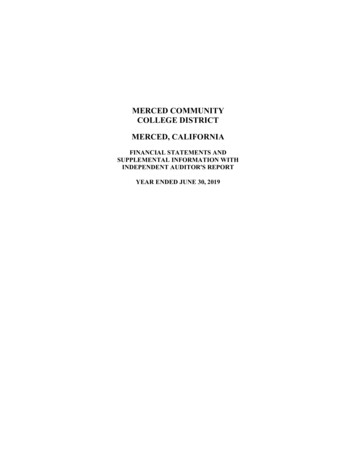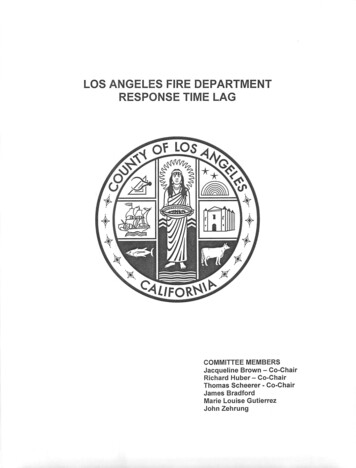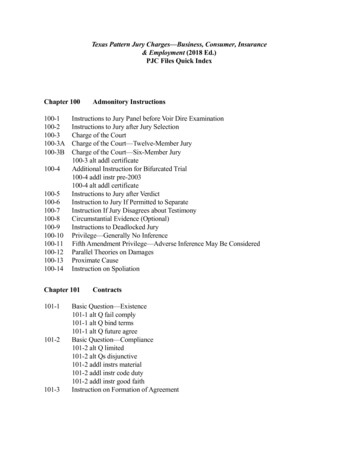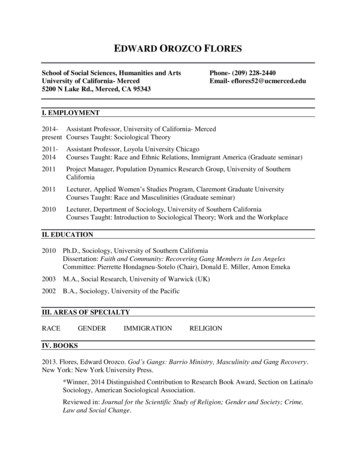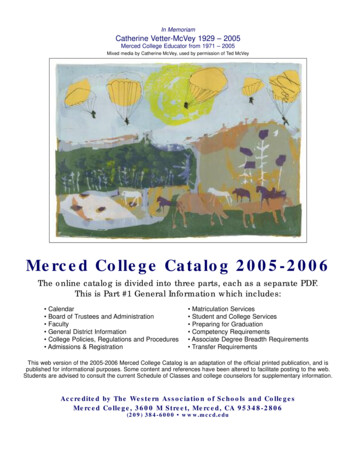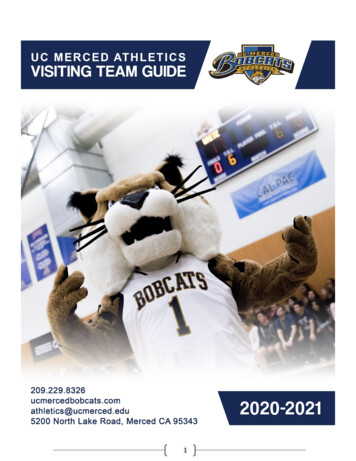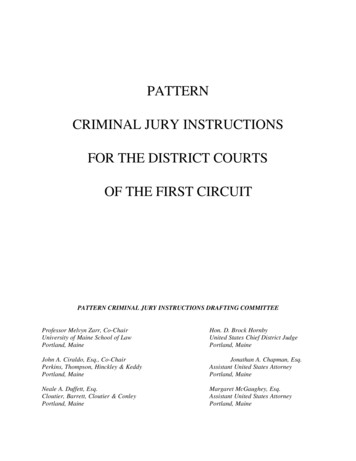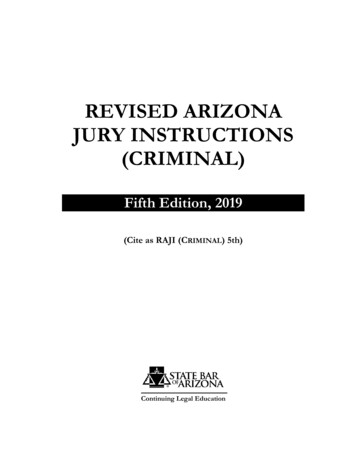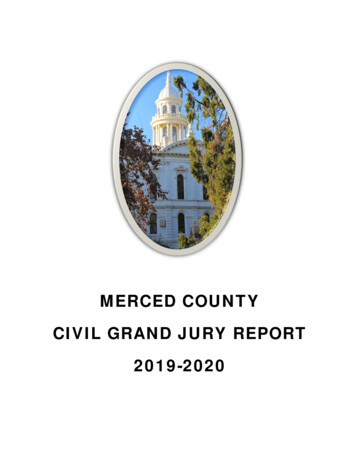
Transcription
MERCED COUNTYCIVIL GRAND JURY REPORT2019-2020
Map of Merced CountyRed pins denote cities where members of the MCCGJ reside.Blue pins denote cities where investigations took place.2
Table of ContentsMap of Merced County2Letter to the Presiding Judge of the 2019-2020 Civil Grand Jury4Civil Grand Jury Members6COVID-19 Statement7Mandated Inspections of Jail FacilitiesJohn Latorraca Correctional Facility89Investigative ReportsMerced City Well 3C1314Observations for Merced Irrigation District Division 3 November 2019 Special Electionand March 2020 Primary Election In Merced County19Is Fog Sealing the Answer: Los Banos Roads Maintenance23Who Holds The Keys To Castle?28Continuity ReportsCompliance and Continuity Reports3233Mandated Inspections of Jail FacilitiesJohn Latorraca Correctional Facility3435Police Departments Within Merced CountyLos BanosMerced383942Iris Garrett Juvenile Justice Correctional Complex44Merced County Public Roads Funding Report463
result in a final report. The complaints led to 9 inquiries resulting in 4 investigative reports.Jurors spent months compiling research, conducting interviews, and evaluating information foreach report. This was a wonderful opportunity for us to learn more about local governmentwhile fulfilling our function as an arm of the court, the voice of the people, and the conscienceof the community.I want to thank my fellow jurors for their hard work and collaborative spirit. We are a diversegroup of dedicated people, imbued with a wide range of expertise and abilities. For all of us, theopportunity to serve the County and its citizens as a Civil Grand Juror has been a rare andprivileged undertaking. We thank those that shared information, resources and time to enableus to conduct our investigations in a logical and thorough manner. We are confident thepositive and constructive responses to our recommendations will result in improved efficacyand improved services for the people of our community.I especially want to thank you, the staff of the Superior Court, County Counsel, CountyAdministration, and County Information and Technology Services. We could not havecompleted our work without your invaluable support. It has been an honor to serve as theforeperson of the Merced County Civil Grand Jury during the 2019-2020 term.Respectfully submitted,Karen Deeming2019-2020 Merced Civil Grand Jury5
2019-2020 MERCED COUNTYCIVIL GRAND JURY MEMBERS1. Armstrong, Laurie2. Bettencourt, Michael3. Deeming, Karen4. de Santiago, Laura5. Foote, Ryan6. Green, Michael7. Hargrove, Richard8. Jackson, Jr., Stoney9. Jorritsma, Eloise10. Krego, Phyllis11. Marcum, Teri12. Martins, Joe13. Mattos, Jr., Weldon14. Murphy, Linda15. Phillips, Levonne*16. Pirtle, George*17. Smith, Rebecca18. Soares, Toby*19. Sousa Jr., Jose20. Tenenbaum, Samuel21. Williams, Steven*Members unable to complete their termForepersonRecording SecretaryPro-TemThe 2019-2020 Civil Grand Jury members resided in the following communities in MercedCounty:AtwaterDos PalosGustineHilmarLe GrandLivingstonLos BanosMercedSnellingWinton6
COVID-19 STATEMENTThe beginning of 2020 has indeed been filled with unprecedented challenges and enormouschange. Despite the disruptions created by the COVID-19 pandemic, the government entitiesand public servants in Merced County strive to fulfil their commitment to the day-to-day tasksthat maintains the community’s viability, with an ongoing emphasis on protecting the healthand safety of everyone. The 2019-2020 Merced County Civil Grand Jury (MCCGJ) has continuedto pursue and complete its tasks, while recognizing the difficulty of collecting information fromindividuals and offices who, burdened with their own priorities, must discover alternative waysto communicate, conduct business, and keep various projects moving forward. As the worldtravels forward into the latter half of the year there will be more changes, interruptions andcomplications to overcome. We are all in this together and Merced County will persist,overcome, and ultimately survive these difficult days and come out better than ever. The 20192020 MCCGJ recognizes the unique and historical nature of our term and appreciates theopportunity to be a part of positive change in our community.7
MANDATED INSPECTIONS OF JAIL FACILITIESINTRODUCTIONIn accordance with the requirements of the California Penal Code (CPC) Section 919(b), the2019-2020 Merced County Civil Grand Jury (MCCGJ) conducted inspections of the detentionfacilities in Merced County. According to CPC Section 919(b), the purposes of these inspectionsare to inquire into the conditions and management of the jails within the county. Under theseprovisions, the Merced County Grand Jury toured and inspected the following facilities:1. The Merced County Sheriff’s Department Main Correctional Facility.2. The Merced County Sheriff’s Department John Latorraca Correctional Facility (JLCF).The MCCGJ inspected the Merced County Sheriff’s Department Main Correctional Facility incentral Merced. The Grand Jury will not issue a report on the Main Correctional Facility as it isnot required by law.8
JOHN LATORRACA CORRECTIONAL FACILITYSUMMARYThe MCCGJ determined that all facilities at John Latorraca Correctional Facility (JLCF) inspectedmet the minimum standards of the California Corrections Standards Authority (CSA), asspecified in Titles 15 and 24 of the California Code of Regulations except for the exercise areas.Title 24 Section 2.10 located in the Board of State and Community Corrections (BSCC) guidelinesstate that the exercise area must contain or provide free access to a toilet, washbasin, anddrinking fountain as provided in Section 1231.3. The exercise area at JLCF does not currentlyallow free access to a toilet and washbasin; however, there are several water stations in theexercise area and according to staff, inmates are escorted to toilets and washbasins whennecessary. Phase I of the remodel will provide the required access to these facilities. The MCCGJfound that the education programs at JLCF reduces recidivism, saving the county funds andgiving participants needed tools to integrate back into society.BACKGROUNDThe 2019-2020 MCCGJ inspected the JLCF located at 2584W. Sandy Mush Road in Merced County (Figure 1) onSeptember 17, 2019. The MCCGJ inspected the conditionsand management of the facility. The buildings wereconstructed in the early 1990’s as a minimum-securityfacility but now houses medium-risk to high-risk inmates.The facility has a state-rated capacity for 564 inmates. Thecurrent population at the JLCF facility as of SeptemberFigure 1: Entrance to John LatorracaCorrectional Facility2019 averages 448 with a 10% female population. Thisincludes approximately 117 documented gang members.This facility maintains the minimum staff required with no relief factor for vacation, sick time,training, or emergency situations. The officers are required to work mandatory overtime whichis often built into their schedules. At the time of the MCCGJ inspection a total of 26,529 hoursof overtime hours had been logged by personnel at JLCF since January 1, 2019.9
METHODOLOGYThe MCCGJ used the Detention Facility Inspection Form provided by the California Grand JurorsAssociation (CGJA). Also reviewed was the Jail Inspection Handbook for Grand Jurors providedby BSCC for reference. The form guided the observations of the MCCGJ during its inspection.The MCCGJ documented facility staffing, condition of the grounds, and the interior and exteriorof the buildings. The medical and kitchen areas were inspected. Educational and vocationalprograms were surveyed, as well as inmate discipline and grievance procedures. Inmateclassification, orientation, visitation, and correspondence policies were reviewed. Inmatehousing units were toured and inmate interviews were conducted. In addition, the Grand Juryreviewed Merced County website material and multiple interviews with staff, CorrectionalOfficers (CO’s), and Sheriff personnel.DISCUSSIONJLCF houses a kitchen that supplies meals prepared by low-risk inmates under the supervisionof staff. Inmates who work in food service have been ServSafe trained. This program is essentialfor proper cleaning, refrigeration, preparation and distribution of food. The kitchen was cleanand in good repair. Menus are reviewed by a licensed dietician annually and meet stateregulated dietary guidelines. Special meals are provided for inmates who have health orreligious restrictions.Staff reported inmates are assessed for medical and mental health needs upon arrival. Themedical facility was found to be clean, organized, and secure. The nursing staff distributesmedications twice daily and provides ongoing care such as glucose monitoring, insulin levelchecks for diabetics and preventative care such as flu shots. In addition to standardexamination rooms, there is a secondary bedding area for long term care, a quarantine locationand a dialysis machine. Mental health care is available via satellite on a weekly basis.In addition to educational programs enabling inmates to receive a high school diploma or GEDcertification, JLCF provides an in-custody treatment program aimed at addressing needs ofparticipants after release. The program courses include: outpatient substance abuse treatment,alcohol abuse treatment, statistical risk offender needs guidance, individual cognitivebehavioral therapy, life skills, moral reconation therapy, anger management, employmentreadiness, education readiness, personal journaling, women’s trauma, and domestic violenceawareness. Program data provided by JLCF shows that the recidivism from 2015 until presentwithout programs is 83% and with programs is at 22%. The reduction in repeat offenders hasreportedly saved the county in excess of 1 million over the course of the program thus far.10
The exercise areas are enclosed by fencing and are located in the center of the CorrectionalFacility. They are bordered on three sides by dormitories which are used as housing for theinmates. The recreation area was found to be clean and in operational order. Staff verified thattwo water stations are located in the recreation area but no direct access to toilets orwashbasins are available.A selection of dormitories was inspected. One dormitory was empty and being remodeled andrepaired. Staff indicated that all the current dormitories were scheduled for remodeling andrepair as part of Phase I project. These units were to be emptied and repaired on a rotatingbasis until all remodeling was completed. The inspected dormitories currently in use appearedto be relatively clean and usable. There was wear and tear noted due to constant use, the ageof the facility, construction materials used when the facility was built, and deferredmaintenance.In November 2015, Merced County qualified for a 40 million grant from the California Board ofState and Community Corrections for construction and renovation of existing buildings at JLCF.Four new buildings are planned including a new health care building with 30 medical/mentalhealth beds and associated clinic area, a new standalone program and services building, a newkitchen and laundry facility, a new intake and release, and administration building with visitingspace. The existing parking lot will be reconfigured into public and secure employee parking.The dorms will be renovated with modifications that increase security including an upgrade tothe toilet and shower area. Additionally, outdoor recreation yards will be constructed withdirect access from the dormitories conforming to requirements for exercise yards. Phase I willalso install upgraded utility systems such as water, septic sewer, electrical, plumbing,mechanical, heating, ventilation and air conditioning. Ground breaking is scheduled to beginApril 2020 with a completion date in January 2023.*FINDING(S)F1:The exercise area is non-compliant and does not provide access to toilets or washbasinsbut does have available drinking water stations. The toilet and washbasin access will beaddressed in Phase I slated to begin in April 2020.*F2:The in-custody treatment program at JLCF reduced recidivism, which saved the countymoney by providing courses that improved the ability of participants to succeed afterrelease.11
RECOMMENDATION(S)No recommendation at this time.*According to staff, COVID-19 has disrupted the process for Phase I.Reports issued by the Grand Jury do not identify individuals interviewed. Penal Code §929 requires that reports ofthe Grand Jury not contain the name of any person or facts leading to the identity of any person who providesinformation to the Grand Jury.12
INVESTIGATIVE REPORTS13
MERCED CITY WELL 3CSUMMARYThe City of Merced Public Works Department oversees the Water Division which is responsiblefor the maintenance and operation of the City’s drinking water production and distributionsystem. The Merced County Civil Grand Jury (MCCGJ) became aware of an excessive disposal ofapproximately 864,000 gallons of water into the storm drain system daily for multiple yearsfrom Well 3C located at 12th and Canal Streets in Merced, California. A new filtration systemwas installed in 2017. The filtration system was contaminated and forced to go offline anddump millions of gallons of fresh water. The problem is not resolved and continues to wastewater. In addition, costs associated with wasted water as well as pumping and testing arepassed on to residents of Merced City during a time when everyone is asked to conserveprecious water resources.BACKGROUNDThe MCCGJ received a complaint claiming the City of Merced was pumping 1,000,000 gallons ofdrinking water per day into the drain system because of a tainted filtration system that wasdiscoloring the water. The original complaint also suggested the water was given away ratherthan sold for an offset of the costs.METHODOLOGYThe MCCGJ conducted multiple interviews with City of Merced Public Works AdministrativeStaff and did research on both the County and City websites concerning water in Merced.Additionally, the MCCGJ toured the Well 3C site and conducted extensive observations at fieldsites. Locations included a pumping station at West Avenue, storm drains, and canals leading toDickenson Ferry Road where water is rerouted into irrigation.The MCCGJ collected correspondence between the City of Merced and the supplier of thefiltration system, laboratory test results for the water from Well 3C, documents reflecting thevolume of water discharged into the storm drain system, maps of the storm drain system,documentation of ultimate destination of water from Well 3C, documents concerning all issuesand problems with Well 3C, documents pertaining to the construction of theTetrachloroethylene (PCE) filtration system, and logbooks for maintenance at Well 3C.14
DISCUSSIONWell 3C is located at the intersection of West 12th Street and Canal Street near downtownMerced. Approximately half (49.7%) of readings taken from well 3C between January 2011 andOctober 2015 indicated that the levels of PCE were above legal limits, indicating that the waterwas unsafe for consumption. In response, the City of Merced had a new filtration systeminstalled at Well 3C including carbon-based filters. The construction was completed inSeptember 2017. According to the Water Department, the well was online, pumping drinkingwater for 30-45 days before the water was rerouted to the storm drain system due to bacterialcontamination from the filters.The City Water Department triedmultiple mitigation methodsincluding backwashing anddisinfecting the system, buteventually they were forced toreplace the carbon filters in May2018. The system remainscontaminated at the time of thisreport. According to the SupervisoryControl and Data Acquisition (SCADA)logs, Well 3C continues to pumpFigure 2: Discharge from pump station on West Avenue.864,000 gallons of water into thedrain system every day (600 gallonsper minute). The Well 3C maintenance logbook reflects Well 3C remained offline (pumping towaste) from 2017 until present. TheMCCGJ was concerned with multipleareas that contained empty lines inthe logbook contrary to bestpractices. When questioned,administration assured the MCCGJthat nothing had been deleted,removed or redacted from thelogbook.The water pumped into the stormdrain travels to the pump stationlocated on West Avenue (See Figure 3) where it is pumped into the MID canal or routed underthe airport to the canal on Thornton Road (See Figure 4) until it enters the MID canal atFigure 3: Discharge under Airport to Thornton Road.15
Dickenson Ferry Road (See Figure 5). According to Water Department officials, MID does notpurchase the water from Well 3C.The cost of water to residents is 0.74 per 748 gallons of water. If the city were selling thiswater at residential rates, the revenue would translate to more than 854 per day or 25,642per month. Additionally, documents show the City of Merced pays an average of 4,305 permonth to power Well 3C while the well is offline and pumping to waste, ending up in MIDcanals for distribution. This monthly loss of nearly 30,000 does not include any costs incurredfrom the additional pumping station on West Ave or any other cost of upkeep for Well 3C.According to the Water Department, turning offor shutting off the water to Well 3C would leadto even greater levels of bio-contaminantbuildup in the system. To remedy the biologicalcontamination in the system and allow thesystem to come back online, a caustic washingservice is needed. An outside contractor hasFigure 4: Thornton Road and Dickenson Ferry City stormprovided an estimate of 70,000 for the caustic drain to MID canal.treatment but will assume no risk orresponsibility for future contamination. The estimated cost includes training Merced Cityemployees to maintain the system properly in the future.Water conservation has been a serious subject in recent years with a state of emergencydeclared in 2014 due to drought. According to the Merced County Water ConservationOrdinance, available on the City of Merced website, minimizing and/or eliminating water wastethrough voluntary compliance or punitive action is necessary to ensure compliance with allfederal, state, and local requirements for water conservation and drought mitigation. The Cityof Merced website cautions that surface water is rapidly depleting and groundwater is beingpulled from the ground faster than it is recharging.The City of Merced website asks residents of Merced California to help conserve water. Thewebsite offers many tips on how to reduce personal and residential use and imposesrestrictions on what type of water use is authorized. Additionally, a strict outdoor wateringschedule is in place. Well 3C has been offline and pumping millions of gallons of water to waste,while at the same time the City of Merced is asking residents to conserve or face penalties fornon-compliance.16
FINDING(S)F1:That Well 3C pumps 864,000 gallons of water into the storm drain system every day.F2:That Well 3C has been offline and pumping water into the storm drain system sinceapproximately November 2017.F3:That the water from Well 3C has been given to MID at no cost to MID.F4:That the cost of the wasted water and pumping costs average close to 30,000 permonth.F5:That the Public Works department received a quote of 70,000 for the causticdisinfection at Well 3C including labor, chemicals, and training for Merced Cityemployees.F6:That the maintenance logbooks contain multiple blank lines between entries.F7:That the public is unaware of the 864,000 gallons of water being pumped into the stormdrain system every day.RECOMMENDATION(S)R1:That Well 3C be disinfected and brought back online by December 31, 2020 ordecommissioned to prevent continued waste of water and costs associated withpumping.R2:That water running to waste from Well 3C be sold or directed to ground water rechargebasins immediately until Well 3C goes back online.R3:That the Public Works logbooks be maintained from this point forward with no blankspaces between entries as best practices for maintaining a proper logbook.R4That the public be informed about the water running to waste from this point forwarduntil it is repaired.REQUEST FOR RESPONSESPursuant to Penal Code §933.05, the grand jury requests responses as follows:From the following individuals:17
Merced City Public Works Director respond to F1, F2, F3, F4, F5, F6, F7, R1,R2, R3 and R4within 60 days.From the following governing bodies: Merced City Council respond to F1, F2, F3, F4, F5, F6, F7, R1,R2, R3 and R4 within 90days.Reports issued by the Grand Jury do not identify individuals interviewed. Penal Code §929 requires that reports ofthe Grand Jury not contain the name of any person or facts leading to the identity of any person who providesinformation to the Grand Jury.18
OBSERVATIONS FORMERCED IRRIGATION DISTRICT DIVISION 3 NOVEMBER 2019 SPECIAL ELECTIONAND MARCH 2020 PRIMARY ELECTION IN MERCED COUNTYSUMMARYThe Registrar of Voters of Merced County invited theMerced County Civil Grand Jury (MCCGJ) toparticipate as official observers at the local electionsfor both the Special Merced Irrigation District (MID)Election held on Tuesday, November 5, 2019 and forthe Primary Election held on Tuesday, March 3, 2020.The MCCGJ found that the poll workers wereFigure 5: Registrar of Voters Electionscompetent, helpful with the processes of voting andthere was reasonable accessibility at most locations. Concerns were found with poll site signageand a lack of preparedness for emergency scenarios. Additionally, ballots were removed fromthe privacy folder before being fed into the machine by the poll worker.BACKGROUNDThe MCCGJ accepted the invitation to observe the elections to ensure the overall integrity andsecurity of the process.METHODOLOGYOn the Monday prior to the November 5, 2019 election, observersmet at the Merced County Elections Warehouse at 250 East 15thStreet, Merced, CA 95341 for an orientation on elections procedures,equipment, guidelines, and other information related to observingthe voting process. During that election, members of the MCCGJvisited multiple polling sites.At each location, the MCCGJ took note of the voting proceduresincluding signage, accessibility provisions, voter check-in, and casting19Figure 6: Voting Booth
ballots. Lack of adequate signage, unassembled booths at some locations, and a lack ofpreparation or procedures for emergency situations prompted the MCCGJ to send a letter tothe Registrar of Voters outlining these observations and concerns.The MCCGJ attended a second orientation for the March 3, 2020 Primary Election reiteratingguidelines for observers and learning about modern technology implemented for greatercommunication and accessibility for voters. The MCCGJ observed multiple voting sites in manyprecincts throughout Merced County.DISCUSSIONFigure 7: Expressvote MachineBy the March 3, 2020 election, there wereupgrades in voting technology. The votingmachine for the disabled was replaced with anew machine that was easier to use and moreadaptable for those with differing types ofdisabilities (See Figure 8). A languagetranslation station with real-time votertranslation assistance was introduced in selectprecincts (See Figure 9). The vote tabulationand ballot collection machines were alsoreplaced with an upgraded model (See Figure10). The way voters checked in changed frompaper to an electronic format (See Figure 11).On March 3, 2020 the California State Primary Election was held. Itcovered the Presidential primary, state and local primary elections, inaddition to municipal ballot measures. All 127 precincts located at 57 sitesthroughout the county participated in this election. Figure 8: Translation MachineVoting Assistance Centers were set up in fourlocations, including Merced, Los Banos, andAtwater. These facilitated early voting, ballot dropoff, and special situations—such as printing ofprovisional ballots. MCCGJ members observedmultiple voting sites. Some precincts are exclusivelyvote-by-mail due to California Elections Code 3005,which stipulates vote-by-mail for all where thereFigure 9- DS200are 250 or less people registered to vote 88 daysFigure 11: PollpadTabulator20
prior to the election.Overall the signage for the majority of polling locations was good; however, some signs weredifficult to see due to size, position and/or location. Signage was not always sufficiently visibleduring evening hours.Concerns with ballot secrecy was noted when the security sleeve was removed by the pollworker before inserting the ballot into the machine, thereby exposing the ballot to public view.When questioned about procedures to ensure vote integrity in an emergency, poll workersprovided a variety of answers regarding training and procedures. Some workers indicated theyhad received some training, while others specified that they had not. Others stated they weretold to take the voting materials only if it was safe to do so. In the event the materials had to beleft behind, the workers were told to call the warehouse for further instructions.As of May 8, 2020, California Governor Gavin Newsom, in consideration of the ongoingconcerns and unknowns regarding COVID-19, has issued a Gubernatorial Executive Orderdeclaring California a Vote-By-Mail state. It is also stated that polling places will be provided forthose who cannot or choose not to participate in the vote-by-mail option.FINDING(S)F1:That there is a lack of adequate training for emergencies at polling sites.F2:That signage visibility and placement issues exist.F3:That ballot privacy is not consistently protected from public view.F4:That the new technology transitioned well into election procedures.F5:That poll workers responded well to the needs of voters.RECOMMENDATION(S)R1:That training for emergency situations is implemented before the November 3, 2020General Election.R2:That signage to polling sites be visible and in well-lit locations for evening voters.R3:That adequate training for the secure and secret handling of ballots be required beforethe November 3, 2020 General Election.21
REQUEST FOR RESPONSESPursuant to Penal Code §933.05, the grand jury requests responses as follows:From the following governing bodies: Merced County Assessor/Clerk-Recorder/Registrar of Voters respond to F1, F2, F3, R1,R2, and R3 within 60 days.Reports issued by the Grand Jury do not identify individuals interviewed. Penal Code §929 requires that reports ofthe Grand Jury not contain the name of any person or facts leading to the identity of any person who providesinformation to the Grand Jury6*Two (2) jurors were recused from this report22
IS FOG SEALING THE ANSWER: LOS BANOS ROADS MAINTENANCESUMMARYThe Los Banos Public Works Department (PWD) Roads Division (RD), located at 411 MadisonAvenue, is in charge of the road maintenance, improvements and replacement throughout thecity. This division is responsible for 130 miles of streets and 5 miles of alleys. Curbs, gutters andsidewalks are also under their jurisdiction. The Merced County Civil Grand Jury (MCCGJ) foundthe majority of the roads in Los Banos are rated below “satisfactory” and need more than fogseal treatments for proper preservation. The MCCGJ recommends that the RD put fundingtoward more substantial repairs of the roads instead of fog sealing roads in “fair-poor,” “poor,”and “very poor” condition. In addition, the MCCGJ recommends the RD provide acomprehensive website to inform the public, and provide a centralized complaint system forreporting problems.BACKGROUNDThe MCCGJ received a complaint regarding street repair procedures. There were concernsabout the expenditure of public funds and resources going toward the substantial expense ofoiling roadways and repainting and striping without first doing any repair, even of significantcracks and potholes.METHODOLOGYMembers of the MCCGJ inspected multiple streets in Los Banos, both thoroughfares andresidential areas. Additionally, the MCCGJ met with management of Los Banos PWD.Documents received included past repair history from 2015 through 2019, street work plan,Pavement Condition Index (PCI), cost of pavement treatment, map of pavement conditions,road repair budget and explanation of repair procedures. The MCCGJ also reviewed the Citywebsite for information about road repairs and maintenance.23
DISCUSSIONThe RD provides a wide range of services that includepavement management, concrete improvements,sidewalk maintenance, painting streets, curb markings,traffic signs and signals, bridges, minor construction,flood control, weed abatement, traffic surveys, and leafremoval.Table 1- City’s PCI CategoriesThe Los Banos RD rates City roads according to theircondition to determine the appropriate rehabilitation,preservation, and repair needed. According to the City of Los Banos Pavement Summary, theCity has an overall Pavement Condition Index (PCI) of 59 which coincides with the “fair”condition assessment chart provided by public works (See Table 1).The cost for treatment and the treatments themselves depends upon the condition of the road(See Table 2).Fog sealing is anapplication of dilutedasphalt emulsion. Theemulsion is used to sealand enrich the asphaltTable 2- Unit cost for pavement treatment corresponding with pavement conditionspavement surface, sealminor cracks, and prevent further deterioration of the street. The application is a preventivemaintenance activity and is scheduled before the street or road shows visual signs of anystructural damage; however, Los Banos RD applies this treatment to all roads, regardless ofcondition.According to the website, the RD sprays about 30,000 gallons of sealer on City streets with thegoal of treating approximately 20 miles orone-fifth of the City streets each year.Management reports that the cycle ofspraying can extend from 5-7 years,depending on the budget.Fog sealing is d
1. The Merced County Sheriff's Department Main Correctional Facility. 2. The Merced County Sheriff's Department John Latorraca Correctional Facility (JLCF). The MCCGJ inspected the Merced County Sheriff's Department Main Correctional Facility in central Merced. The Grand Jury will not issue a report on the Main Correctional Facility as it is

